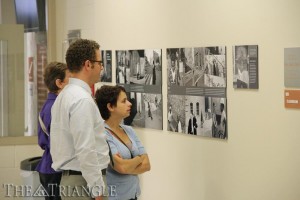The Perspectives on Peace exhibition’s opening reception Sept. 19 celebrated the Peace Day Philly initiative with photography collections on display at Drexel’s James E. Marks Intercultural Center.
The exhibition, which will be on display until Oct. 31, features the work of five Philadelphia photographers as a collaborative observance of the International Day of Peace as presented by Drexel University, Peace Day Philly and the American Society of Media Photographers.

The artists had the freedom to display the theme within very broad terms, allowing them to choose pieces from their own collections that reflected sanctuary.
Mencher’s collection included photos of people and animals swimming, boating and relaxing in and near Lake Atitlan in Guatemala, a site where people of the surrounding towns often went to escape their country’s civil war.
“The whole idea is basically how people in this lake area saw some great tragedy during their country’s long civil war. It’s a place of sanctuary even though they were in the civil war,” Mencher said.
A more local spin was put on the theme of sanctuary in Bones’ collection, which featured portraits of participants of Pathways to Housing, a program that offers a housing-first approach as a solution to homelessness.
Bones displayed a collection of portraits of program participants in their new homes alongside portraits of the same participants in the places where they used to sleep.
“I like to document projects that I feel are noble and worthy, and this is just such an amazing solution to me,” Bones said. “Basically, it’s told me anyone can change. We’ve all got the capacity to change.”
The collections of Addis, Wood and Salzmann also showed international or local images representing the idea of sanctuaries.
Addis, a Drexel graduate, shared photographs of buildings, most of which were taken from bird’s-eye view and showed roofs overflowing with garbage, animals, ladders and satellite dishes.
“It’s not only about the artistic part but also about what people see,” Andre Janko, an electrical engineering graduate student, said about the satellite dishes cluttered on the rooftops in Addis’ photos. “Antennas caught my attention because I’m an electrical engineer.”
Wood’s collection displayed photographs from communities in both Nicaragua and Prevention Point Philadelphia, a community health and education center.
Jessica Snyder, a mechanical engineering graduate student, responded to Wood’s photographs of people associated with Prevention Point Philadelphia.
“I love pictures of Philadelphia. … [Viewing them] makes you proud of your city because you see people happy and thriving and doing things like the prevention clinics and things like that. It’s just great, and it makes you feel proud and connected to the community that you’re a part of,” Snyder said.
Salzmann displayed two collections, “City/2,” which featured photos of people in Philadelphia’s public spaces in the 1970s, and “Jerusalem’s People in Public,” which shared a similar idea, exploring public spaces in Jerusalem where people of different faiths did or didn’t meet, Salzmann said.
About 75 people attended the opening reception. Light refreshments were served as guitarist Andreas Arnold played multicultural music for guests.
Drexel first participated in Peace Day Philly in 2011, but this year was the first year that Drexel received funding from the United States Institute of Peace to support the programs, according to Heidi West, director of international programs at Drexel.
“Peace Day Philly and our engagement in this project is really about connecting people through collaborative efforts that inspire action and social change, and so that’s really what we’re kind of hoping to do by bringing people together through the arts and music and through academic engagement,” West said.


